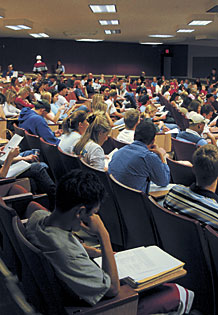 |
|
David Harden/Arizona Daily Wildcat
|
Students attend a Communications 101 class in a crowded lecture hall in Harvill yesterday.
|
|
By Bob Purvis
Arizona Daily Wildcat
Thursday January 16, 2003
With an enrollment increase of more than1,000 students this semester, departments are struggling to accommodate students amid course cuts.
Many departments have been forced to increase class sizes and web-based classes to deal with this semester's influx. Yet some students are still left without full schedules.
"I know a lot of people who are stuck with like seven units," said undecided freshman Amy Zetah.
Even students nearing graduation are finding themselves without many of the classes necessary for their degree.
"You look on the Internet, and there is one upper-level class. It's ridiculous," said fine arts junior Sjelly Reiser.
Major budget cuts have forced some departments to cut sections and increase seat capacity in courses, leading many professors to take on more classes on a volunteer basis, said Maurice J. Sevigny, dean of the College of Fine Arts.
The fine arts faculty, which is faced with a 50-1 student-to-faculty member ratio, is struggling to meet this semester's demand.
"More and more effort is being focused towards majors," Sevigny said, "We will have less ability to be available to nonmajors outside of gen-ed classes."
Other departments are doing all they can to avoid overloading courses. The journalism department, which has seen a 25 percent enrollment increase this semester, has looked to other areas to allow them to continue to offer smaller class sizes. The department recently froze faculty travel and has cut operating budgets, even opting to hold off on the purchase of a new copy machine.
"A lot of things have been eliminated," said Paul R. Johnson. undergraduate advisor in the department of journalism, adding that increasing class sizes in upcoming semesters is dependent on future budget cuts.
Some students worry that boosting class sizes will strain their academic performance.
"It (increased class size) makes it harder to learn in a class where you may need more one-on-one attention," said creative writing sophomore Taylor Gunn.
The larger classes are also making it harder for departments to keep up the frenzied pace they have assumed in order to meet students' needs.
"The lack of predictable funding for these classes continues to create problems for us in planning course offerings, and of course, it creates problems for students," said Larry Evers, department head of English.
Although the department of English has been able to provide required classes for those who need to graduate, the department's ability to provide diverse course offerings has been reduced, Evers said.
Students who wish to ensure their spot in quickly filled classes should register early and count on taking summer and winter terms in order to graduate on time, Sevigny said.
Also, students should be sure to check their Student Academic Progess Report to check class standing and priority registration opportunities.

